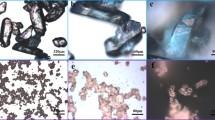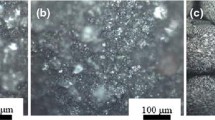Abstract
The chemical reactions in the SiCl4-Si-H2 system using a low temperature hydrogenation technique related to the Siemens process were studied based on thermodynamics. The diagrams of standard Gibbs free energy of formation and equilibrium constants for seven reactions used as a function of temperature in this system were calculated and plotted for a temperature range of 473 K to 1073 K. It showed that the lower the temperature, the larger the conversion ratio of SiCl4. The equilibrium composition of gaseous species in the SiCl4-Si-H2 system with different initial SiCl4/H2 ratio and systematic pressure was calculated and the corresponding conversion ratio of SiCl4 was obtained. The conversion ratio was improved by increasing the initial ratio of H2 in raw materials and the systematic pressure but was reduced with the increase of temperature. The conversion ratio of SiCl4 reached 0.41 with an initial SiCl4/H2 ratio of 1/5 and a systematic pressure of 5 MPa at 473 K.
Similar content being viewed by others
References
Woditsch P, Koch W (2002) Solar grade silicon feedstock supply for PV industry. Sol Energy Mater Sol Cells 72:11–26
Sarti D, Einhaus R (2002) Silicon feedstock for the multi-crystalline photovoltaic industry. Sol Energy Mater Sol Cells 72:27–40
Braga AFB, Moreira SP, Zampieri PR, Bacchin JMG, Mei PR (2008) New processes for the production of solar-grade polysilicon: A review. Sol Energy Mater Sol Cells 92:418–424
Lee JY, Lee WH, Park Y-K, Kim HY, Kang NY, Yoon KB, Choi WC, Yang O-B (2012) Catalytic conversion of silicon tetrachloride to trichlorosilane for a poly-Si process. Sol Energy Mater Sol Cells 105:142–147
Gusev AV, Kornev RA, Sukhanov AY (2006) Preparation of trichlorosilane by plasma hydrogenation of silicon tetrachloride. Inorg Mater 42:1023–1026
Sirtl E, Hunt LP, Sawyer DH (1974) High temperature reactions in the silicon-hydrogen-chlorine system. J Electrochem Soc 121:919–925
Taylor PA (1988) Purification Techniques and Analytical Methods for Gaseous and Metallic Impurities in High-Purity Silane. J Cryst Growth 89:28–38
Acker J, Bohmhammel K (2008) Thermodynamic assessment of the copper catalyzed direct synthesis of methylchlorosilanes. J Org Chem 693:2483–2493
Iya SK (1986) Production of ultra-high-purity polysilicon. J Cryst Growth 75:88–90
Mörke W, Vogt F, Wendlandt K-P (1993) Catalytical conversion of silicon tetrachloride to trichlorosilane. J Chem Soc 89:1085–1087
Acker J, Röver I, Otto R, Roewer G, Bohmhammel K (2001) Formation of transition metal silicides by solid-gas reactions: thermodynamic and kinetic consideration. Solid State Ionics 142:583–591
Odden JO, Halvorsen G, Rong H, Gløckner R (2008) Comparison of the energy consumption in different production processes for solar grade silicon. In: Øye HA, Brekken H, Foosæs T, Nygaard L (eds) Silicon for the Chemical and Solar Industry IX, Oslo, Norway, pp 75–90
Ingle WM, Peffley MS, Nagaraja HS (1985) Triehlorosilane Production Process. US Patent, 4526769
Sarma KR, Chanley CS (1985) Process for the hydrogenation of silicon tetrachloride. US Patent, 4542004
Acker J, Bohmhammel K (2002) Reactivity of intermetallic compounds: a solid state approach to direct reactions of silicon. J Phys Chem B 106:5105–5117
Bohmhammel K, Roewer G, Walter H (1995) Hydrodehalogenation of chlorosilanes in the presence of metal silicides: experimental studies of gas and solid phase composition related to thermodynamic calculations. J Chem Soc 91:3879–3882
Hou YQ, Xie G., Tao DP, Yu XH, Li RX, Song DM (2011) Thermodynamics of transformation process from SiCl4 to SiHCl3. The Chinese Journal of Nonferrous Metals 21:3202–3210. (in chinese)
Miao JJ, Qiu KQ, Gu H, Chen SC (2008) Thermodynamic behavior of SiHCl3 and SiCl4 in Siemens system. The Chinese Journal of Nonferrous Metals 18:1937–1944. (in chinese)
Kee RJ, Rupley FM, Miller JA (1990) The thermodynamic data for silanes and chlorosilanes. Sandia National Laboratories Report, Sandia
Author information
Authors and Affiliations
Corresponding authors
Rights and permissions
About this article
Cite this article
Wu, J., Chen, Z., Ma, W. et al. Thermodynamic Estimation of Silicon Tetrachloride to Trichlorosilane by a Low Temperature Hydrogenation Technique. Silicon 9, 69–75 (2017). https://doi.org/10.1007/s12633-015-9353-0
Received:
Accepted:
Published:
Issue Date:
DOI: https://doi.org/10.1007/s12633-015-9353-0




